1001 Nights of Marrakech: Best Things To Do There
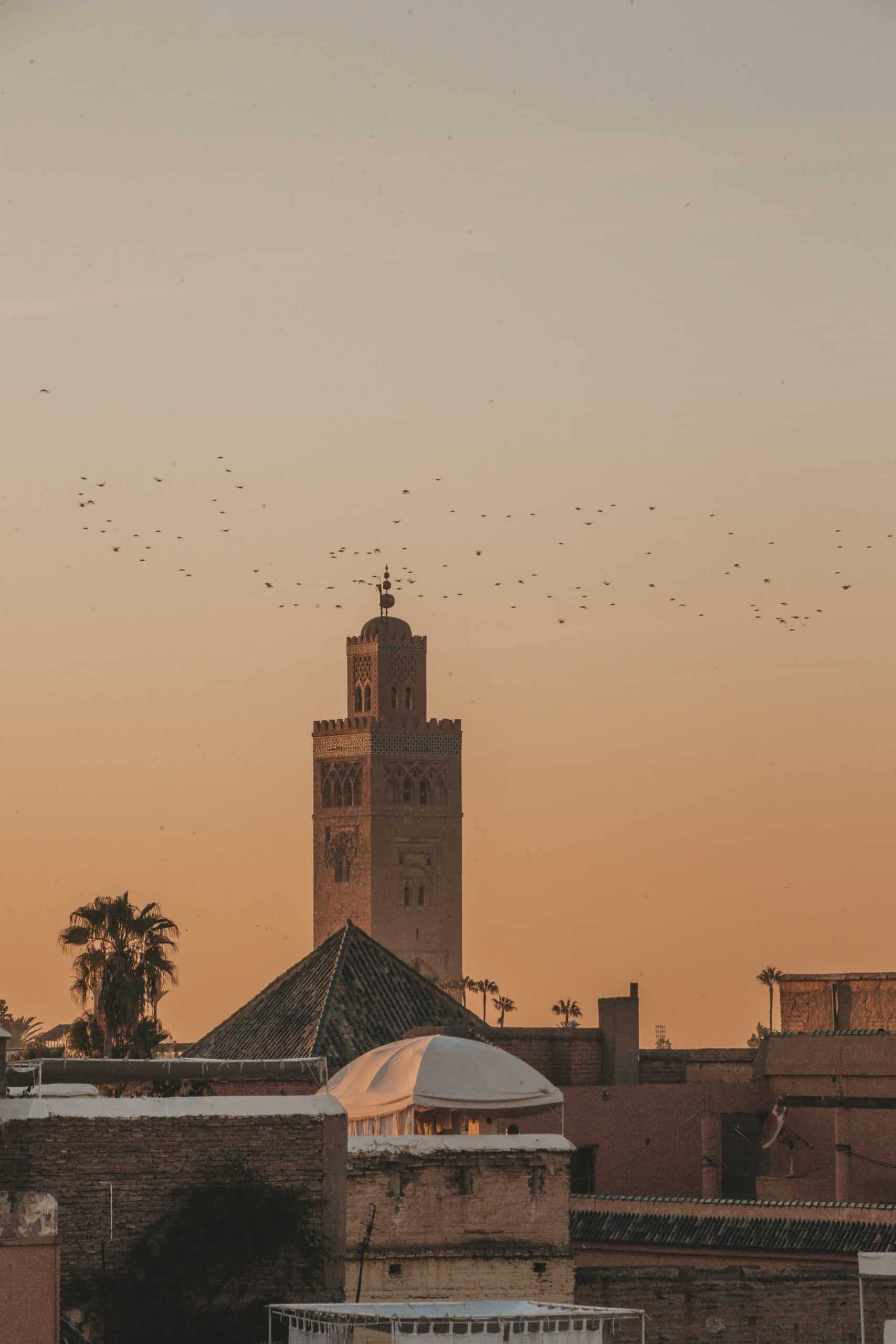
Updated On: April 22, 2024 by Esraa Mahmoud
The landlocked city of Marrakech lies on the edge of the Sahara Desert and borders the Atlas Mountains range. It is one of the four Moroccan royal cities, along with Fes, Meknès, and Rabat. You can see the city’s medieval roots everywhere as you stroll through the souks in the medina (old city), whose snake charmers, carpet sellers, spice stalls, and herbalists will stimulate every sense in you.
Marrakech is often referred to as the “red city” because many of the buildings and especially the walls of the city (which, by the way, have been a UNESCO World Heritage Site since 1985) shine in a reddish shade of ocher.
In Morocco, the color red stands for power and fire, for infinity and vastness – but it is by no means the only color you see here. If you stroll through the medina, every conceivable color reveals itself to you, in the form of spices, pictures, and flowers, on carpets and tableware, on clothing and jewelry. In fact, you will be overwhelmed with the colorful spectrum in the city.
There is so much to be done and so many places to be visited in Marrakech. This is a city where you almost never run out of new things to do and places to visit. Providing you with the Crème de la crème of Marrakech, here are the best things to do in Marrakech and the places to visit.
The Charming Old Medina of Marrakech
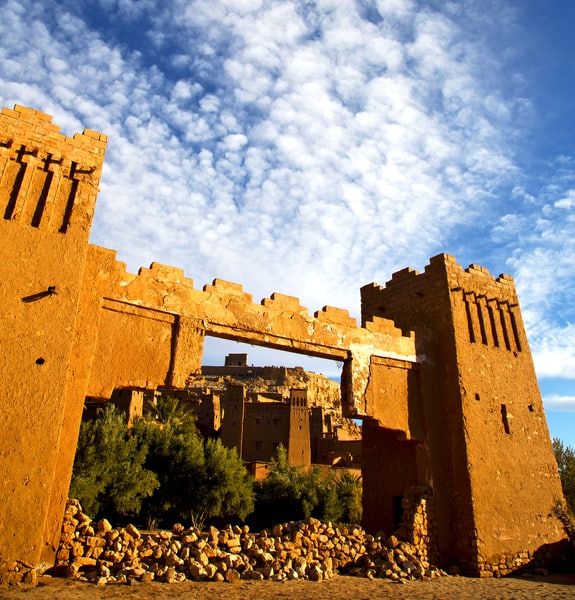
The medina is a term used to describe the old town of Arab cities. The old medina is the historic heart of the city of Marrakech. Just in the middle of the hustle and bustle, the small alleys of the medina immediately swallow all the noise as soon as you step into them. In there, you can experience the flair of 1001 nights.
The UNESCO World Heritage Site has existed since the 11th century, and it is the best start to your trip to Marrakech. The medina could be best described as a portal that would take you to another world full of ceramics, spices, argan oil, silver jewelry, bedspreads, leather goods, and rugs.
In the old medina, you can also just watch the craftsmanship: soldering the lamps, dyeing the fabrics, carving, as the workshops are scattered among the stores. You should not be afraid of getting lost; on the contrary, it is one of the many charms of the city to get lost in its labyrinth and to get to know corners that you would never have found otherwise.
A tour of the colorful medina of Marrakech is best done on foot and can be done safely without a guide. However, if you are not a fan of exploring on your own, a guide can bridge you to local craftsmen in Marrakech and translate. The whole guide business is strictly supervised in Morocco to protect the tourists, which is quite assuring. The old medina is a must-visit on your trip to Marrakech.
The Famous Souks
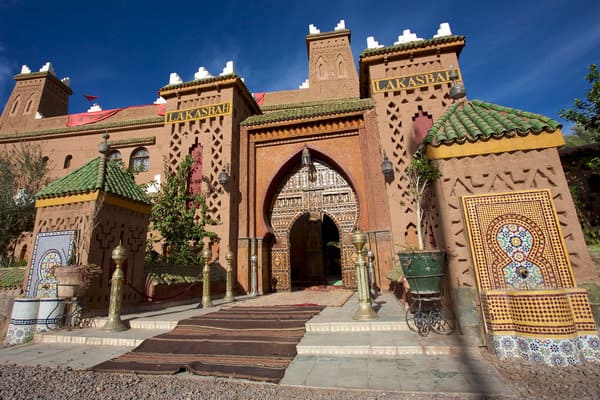
With a size of about 20 hectares, the souks in Marrakech are considered the largest bazaar in Morocco. It would take days to look at everything in peace, plus the narrow alleyways are laid out like a labyrinth, and you constantly get lost. But that’s exactly what makes it so magical – in addition to all the goods you can buy.
Whether colorful ceramics, handmade wool and silk carpets, spices, jewelry, Berber caps, or Argan oil, there is nothing that is not available. Here you can find anything your heart desires.
Two tips to consider while shopping in the souks. One: Bargain, bargain, bargain, and bargain! Negotiating the price with the seller is a big part of the culture in Morocco. The rule here is to negotiate the former price down to at least half – and always do it calmly and with a smile. Shopping in the souks is a ritual that should be celebrated.
Two: The deeper in the street tangle, the more favorable are the prices. Because the stalls at the edge are often only made for the tourists and often sell at expensive prices.
Jemaa el-Fnaa
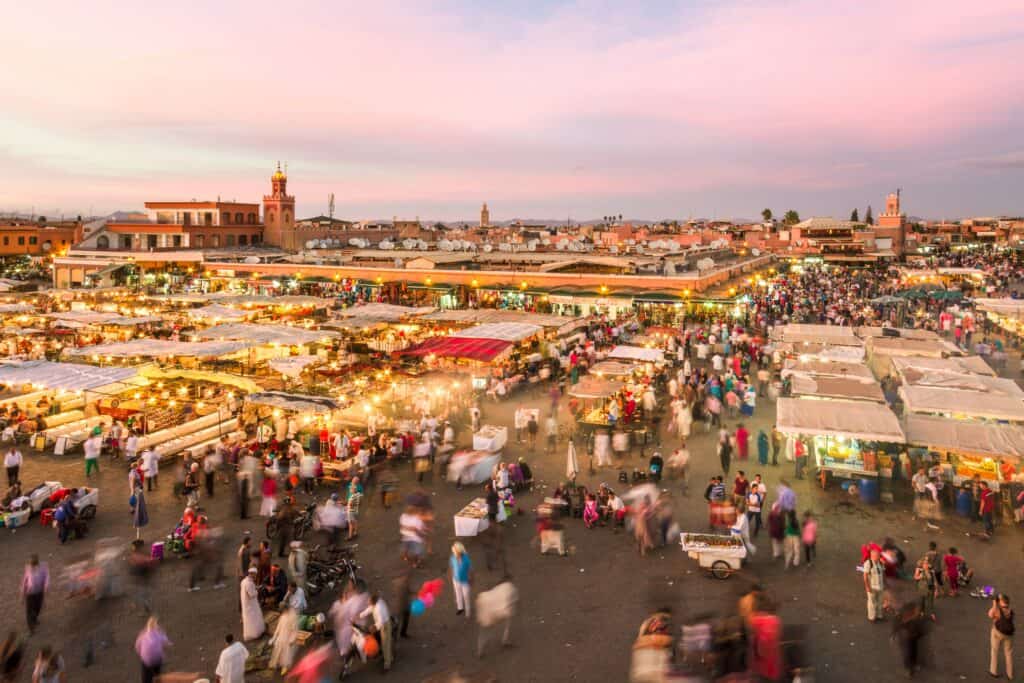
One of the highly recommended markets or Souks to visit while in Marrakech is definitely Jemaa el-Fnaa, AKA Jemaa el-Fna, or Djemaa el-Fna! This is the place to be – the central main square in the medina. This place is extraordinary, to say the least, and absolutely fascinating. Jemaa El-Fnaa is one of the most beautiful sights of Marrakech.
Jemaa el-Fnaa is a mix of the chaotic, noisy little world of jugglers, fortune tellers, food stalls, henna painters, donkey carts, snake charmers, and flying merchants. A visit to Jemaa El-Fnaa is unforgettable – especially in the evening.
The best thing to do while there is to take some time to leisurely walk around and across the entire square. You should sit down in one of the chic cafes, drink mint tea and let the hustle and bustle work its magic on you – it certainly won’t be boring here!
There are also numerous airy rooftop terraces from which you can get an even better view of the action, the dream view of the snow-capped mountains on the horizon, and the 70m-high minaret of the Koutoubia Mosque.
We highly recommend visiting the Jemaa El-Fnaa at different times of the day. In the morning, there is a completely different atmosphere than in the evening.
The Place de Epices
One of the most beautiful places in Marrakech is the famous Rahba Kedima square, AKA Place des Epices. Not only is the spice square a great place to shop for everything from spices and tableware to blankets and rugs, but there are also many bars and cafes where you can drink tea and watch the hustle and bustle from above.
The most popular and casual café in the square, which we highly recommend, is the “Café de Epices” with its red-painted facade. The café is so famous that it is mentioned in almost every guidebook. With such fame, the place is usually crowded; however, there are a few other places from which you can have an equally beautiful view – and you can even watch the hyped café, for example, from the terrace of the “Café Shtatto”.
Bahia Palace
The Bahia Palace, built in 1867, is one of the largest palaces in the city. The Palace is so big and so amusing that you can spend a whole day marveling at what is inside.
The Palace has a floor area of 8,000 m² and has over 160 rooms, countless patios, and many so-called riads; a riad is a traditional Moroccan house or Palace with an inside garden or courtyard. Everywhere in the Palace, you will encounter an Andalusian and Moorish architectural style.
Although the rooms are empty today, they still look impressive and give a glimpse of the luxurious life of the rulers who once lived here. Almost every room has faiences, ornate marble tiles, fanciful mosaics, and arabesques in stucco. The ceilings of the rooms were carved in Moorish style from cedar wood and decorated with many small details.
The beautifully landscaped courtyards with their archways and lushly planted gardens invite you to relax and unwind. Within its vast grounds, take a moment to appreciate the luxurious riads with fretted glass windows, intricate marquetry, cedar ceilings, mosaics, and shaded courtyards…… Oh, how marvelous!
The Palace is located on the Rue de la Bahia, and it is open from 09:00 AM to 4:45 PM. Tip: If you want to avoid the crowds, you should visit the Palace early in the morning.
El-Badi Palace
Leaving the old town in Marrakech in a southerly direction, you will come across what was once one of the most beautiful palaces in the city, El-Badi Palace, of which only the massive remnants of the walls remain today. The Palace was built by Sultan Ahmed El-Mansour between 1578 and 1608.
El-Badi Palace was once the largest in the country; things are quieter here, visually and acoustically than in the neighboring Bahia Palace or the Ben Youssef madrasa with its thousands of colorful tile collages. At El-Badi palace, you can digest the sensory impressions of the city and pause in awe at its sheer grandeur.
The Palace is an architectural masterpiece, and its sand-colored ruin would be the perfect background for many great photos for your Instagram.
The Atlas Mountains with Kasbah Stops
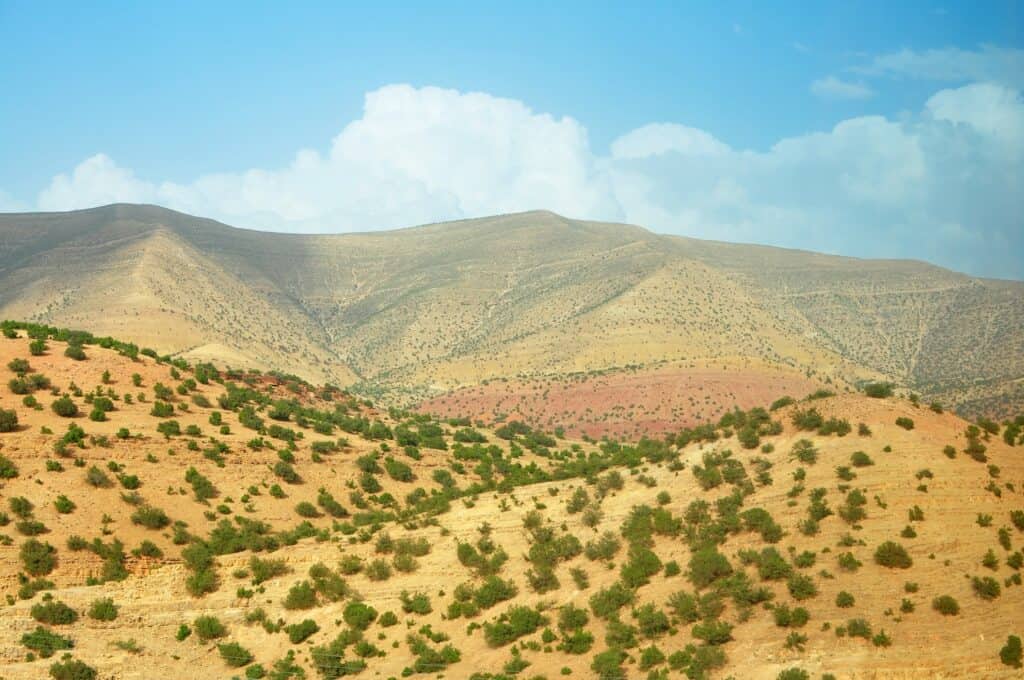
Marrakech is positioned at the gates of the Atlas Mountains range. The mountains are a paradise for active vacationers. Especially hikers who will certainly get their money’s worth here. There are guided hikes of several days through the mountains, and there are also day hikes and excursions.
To get a grasp of Marrakech, you’ll need to leave the city walls. Hire a driver or, if you’re feeling like it, a car yourself and explore the High Atlas. The landscapes of the High Atlas, with their endless expanse, glowing hills, and houses, are magical.
While in the area, you have to head to the road of 1000 Kasbahs from Ouarzazate north towards the valley Dades Gorge, between Atlas and Anti Atlas. Kasbahs (type of fortresses) once provided protection for families and their goods as fortresses. They are built of mud, and they have some well-done artifacts of the most beautiful Berber art.
The most prominent of these is Aït-Ben-Haddou, which is the location where films such as Gladiator and Laurence of Arabia were shot. Aït-Ben-Haddou is a fortified village, and it is located south of Marrakech and is one of the best places in Morocco.
Since 1987, the Aït-Ben-Haddou complex has been on the UNESCO World Heritage List – exemplary of the Kasbah architecture typical of southern Morocco.
Le Jardin Majorelle
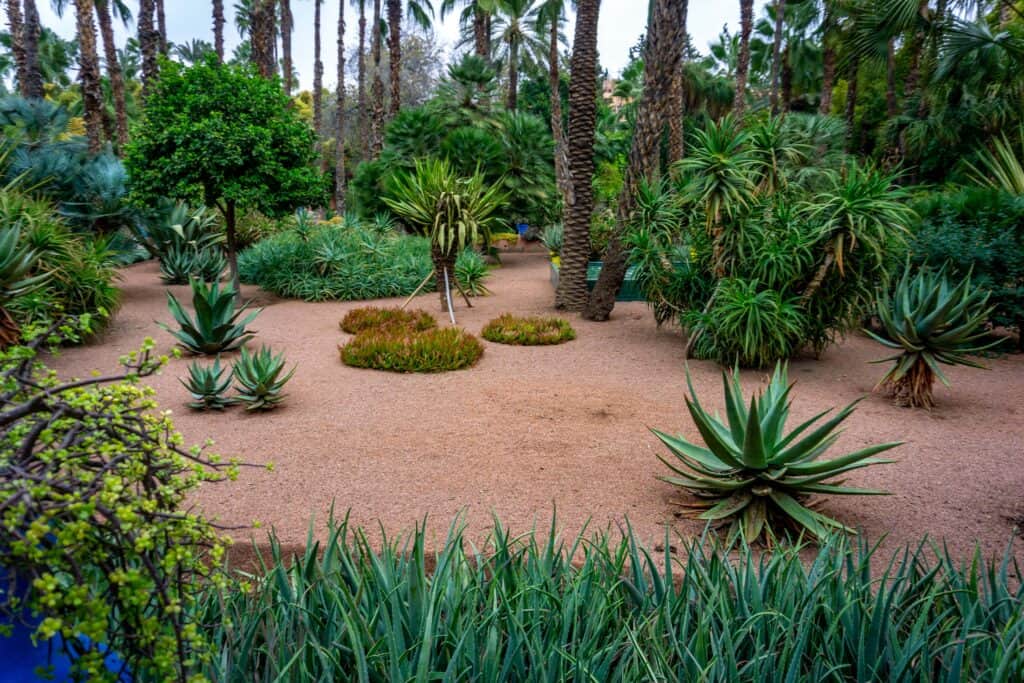
Setting in the midst of the hectic metropolis of Marrakech, the magnificent garden of Le Jardin Majorelle was created by the late French painter Jacque Majorelle in the course of almost forty years! Seems to always be an attraction to creative minds; the garden was bought and restored years later by the brilliant fashion designer Yves Saint-Laurent and partner Pierre Bergé in the 1980s.
Moving years forwards, the garden became open to the public in 1947. Le Jardin Majorelle is the perfect place to relax and to immerse yourself in a fascinating world. Le Jardin Majorelle is one of the main attractions of Marrakech, and it is most famous for its cobalt blue color that can be seen everywhere in the garden.
In the garden, besides some typical cobalt blue buildings, there are more than 300 different plant species coming from different continents. The garden is a work of art with its cooling shade of the countless plants and the many watercourses that provide mild temperatures and eagerly invite you to relax on one of the small benches along the way.
The center of Le Jardin Majorelle is decorated by a cobalt blue pool with a fountain in the middle and some water turtles inside. At the back of the garden, there is the memorial stone of the French fashion designer Yves Saint Laurent, who lived for a long time in Marrakech, during which he restored the garden.
There are many more to see at Le Jardin Majorelle, like the palm trees, the outstandingly tall cacti, among other things. There are also paintings by Yves Saint Laurent exhibited in a small showroom on the grounds. In addition to a museum with Islamic art, folklore exhibits, and paintings by Jacques Majorelle. A visit to Le Jardin Majorelle is one of the top things to do in Marrakech.
Saadian Tombs
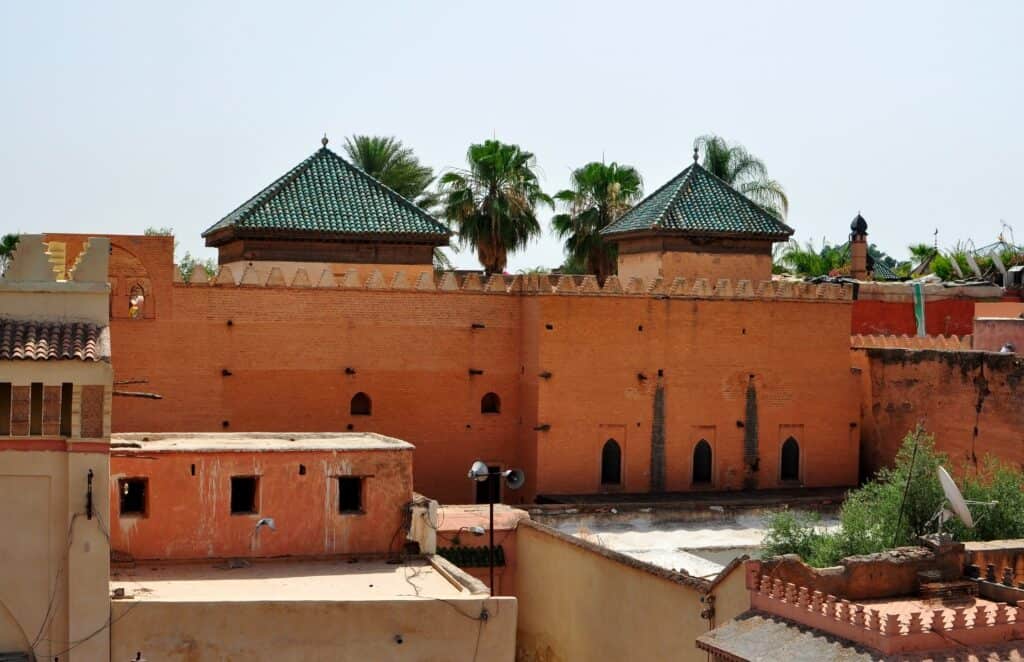
The Saadian Tombs, like all of downtown Marrakech, are a UNESCO World Heritage Site and served as the Saadians’ main burial site from 1557 to 1664. The historic royal necropolis is located directly behind the Mosque al-Mansur in the south of the medina and can be reached today only through a narrow passage.
For many years the tombs were forgotten because the entrance was walled up. Today, anyone (with a little patience while waiting in line) can take a look inside the mausoleums, some of which are lavishly decorated and an absolute pleasure to behold! Make sure to give the Saadian Tombs a visit; you won’t regret it!
Ben Youssef Madrasa
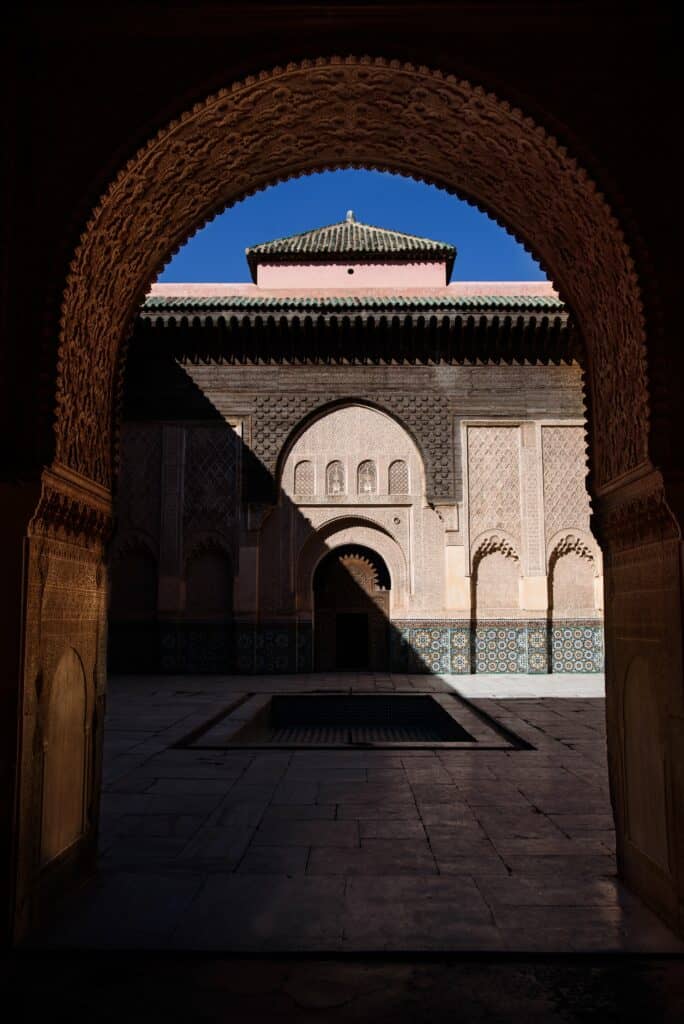
You probably already know the former Ben Youssef Madrasa from Instagram; it is just everywhere! Ben Youssef Madrasa is THE hotspot for beautiful photos! Ben Youssef Madrasa was an Islamic madrasa (School) in ancient times. The courtyard of the madrasa is pierced in the middle by a water basin, where religious ablutions were once performed. Also, the walls are covered with colorful mosaics, scrollwork, and wooden ornaments.
You can’t make it to Marrakech without paying a visit to Ben Youssef Madrasa…It would be a shame! After admiring the beauty of the place, snap as many photos as you can; with such a perfect location, there are very limited chances that the photos would be anything but spectacular!
However, try to go early in the morning or late in the afternoon, otherwise it will be hard to take pictures without other tourists.
Oh, That Moroccan Tea, Though!
Marrakech has many great drinks that you must try; however, for the real Marrakech feeling, drink tea: hot, frothy, and from small glasses. The best-known variety is Thé à la Menthe; a strong green tea served with lots of sugar and fresh mint. You can also buy the tea leaves in the souks to enjoy the taste of the city again at home after your trip.
Tip: The perfect Moroccan tea can be recognized by the fact that it foams. This is achieved by a simple hand movement: The teapot is lifted high above the glasses, and only then is the tea poured. The height creates the famous foam on the tea…. So yummy!
Eat & Cook Too!
Morocco is bursting with culinary treasures: pomegranates, oranges, dates, almonds, and the list goes on. Moroccan cuisine is characterized by spices. Probably the most famous dish is the tajine, a stew cooked in a typical clay pot in the oven. It is available in all variations with different kinds of meat or fish mixed with potatoes and vegetables, but also in vegetarian versions.
To help you enjoy the real Moroccan cuisine in Marrakech, here are some restaurants to consider while in the city. First, there is Dar Essalam; this is a traditional restaurant in the medina that opened in 1952 and is still run by the same family.
The restaurant became famous after being featured in the Hitchcock thriller “The Man Who Knew Too Much” with James Stewart and Doris Day, among other films that were shot there as well. The interior is classic Moroccan and decorated with great attention to detail. The food is very sumptuous and meat-heavy, but there are also delicious vegetarian options.
Another good restaurant you should visit is Riad Dar Moha. In Riad Dar Moha, you get to sit in a quiet courtyard with a pool while a wide variety of appetizers, main dishes, and desserts are served. The place is perfect for getting introduced to the Moroccan cuisine.
There is also Riad Kniza, which is the best place for a leisurely dinner. With its classic Moroccan lounges and the idyllic rooftop terrace, the restaurant offers a diverse menu of classic and vegetarian options.
Last but not least is Café de France; this is a famous café on the edge of Jemaa el-Fnaa with the best view of the square. The food is good, and you can enjoy a mint tea while soaking up the atmosphere and watching the square change between day and night.
The more you learn, the more you’ll want to know about Marrakech. The city has so many layers and histories, geographically as well as culturally and politically. With a charm of the old world and breathtaking sights that would sweep you off your feet, Marrakech is a city full of great things to do and amazing places to visit.






